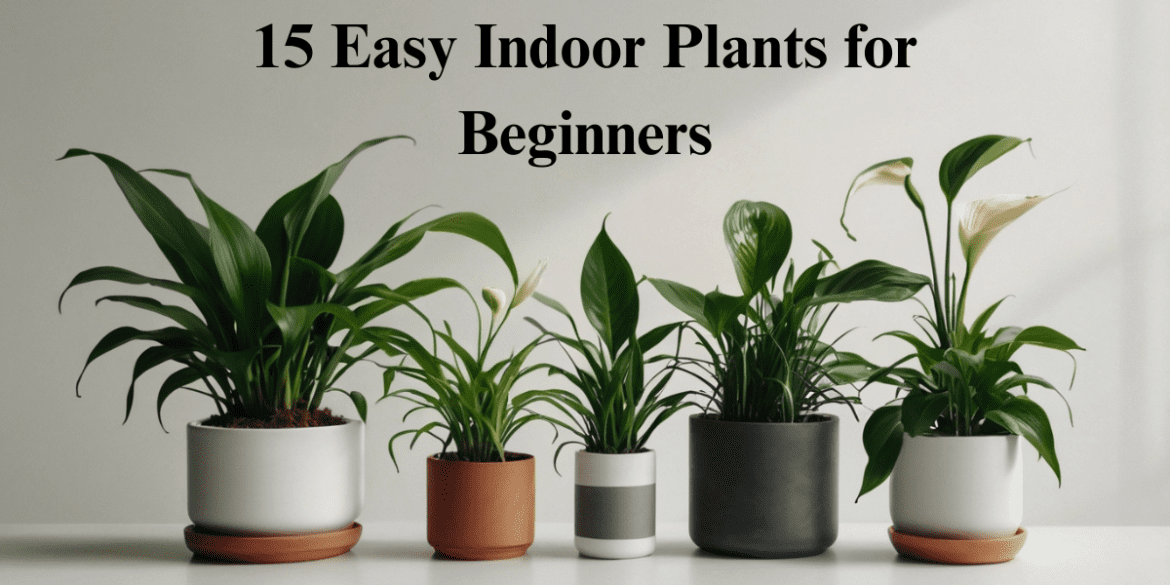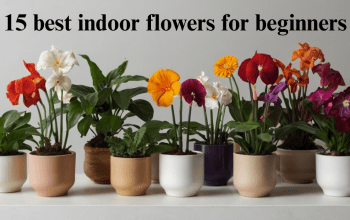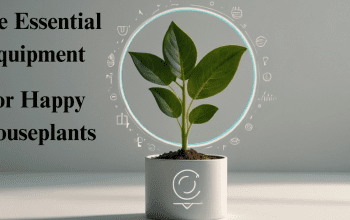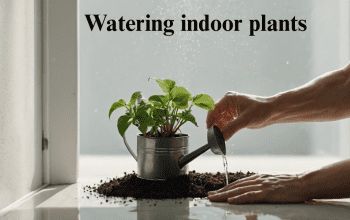So, you’ve decided to bring some green into your home? Good call. Plants don’t just sit there looking pretty—they purify your air, brighten up your mood, and honestly, make you look way more put-together than you actually are. (Let’s be real, having a thriving indoor plant is basically adulting on hard mode, and you’re about to nail it.)
But here’s the thing: not all plants are beginner-friendly. Some are like divas—they want the perfect amount of water, just the right lighting, and if you mess up even slightly… well, let’s just say your Instagram-worthy plant shelf turns into a tiny graveyard. We don’t want that.
That’s why this guide exists. I’m going to walk you through 15 easy indoor plants for beginners—plants so chill and forgiving that even if you forget to water them for a week (or two), they’ll still be standing strong, silently cheering you on.
Think of them as the “starter pack” of houseplants: low-maintenance, hard-to-kill, and guaranteed to add life to your space without demanding too much in return.
By the end of this article, you won’t just know what plants to get—you’ll also know why they’re great for beginners, how to care for them without overthinking, and which ones will make your friends say, “Wow, you’ve really got your life together!” (even if you ordered pizza for the third night in a row).
Ready? Let’s dive into your new leafy lineup. 🌱
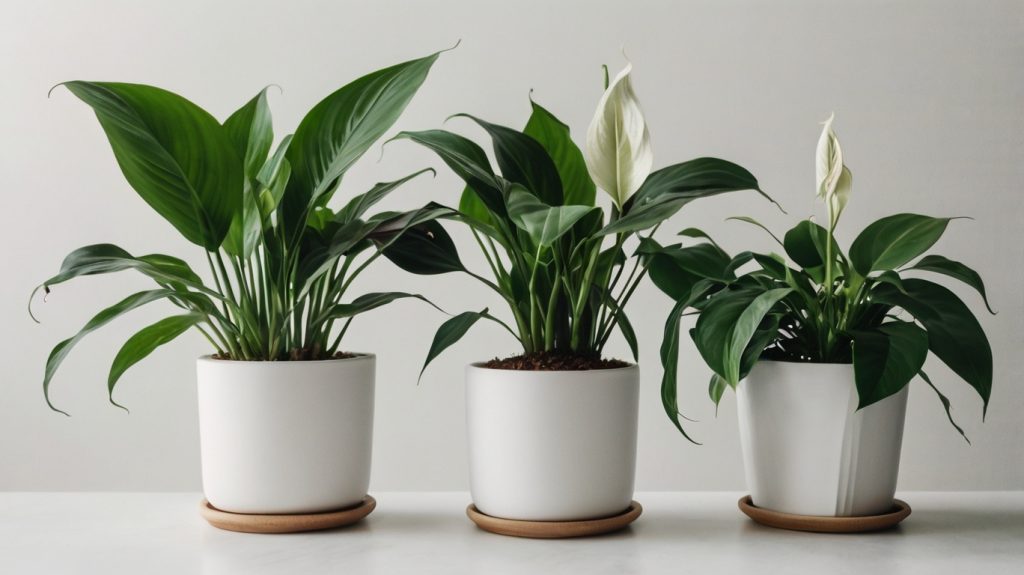
1: Snake Plant (Sansevieria)
The Snake Plant, also known as “Mother-in-law’s Tongue” (ouch), is basically the Chuck Norris of the plant world—tough, resilient, and able to survive almost anything. Forget to water it? No problem. Stick it in a corner with barely any light? Still fine.
This plant thrives on neglect, which makes it perfect for busy beginners. Plus, it’s an air-purifying champ, quietly cleaning toxins out of your home while looking sleek and stylish with its tall, sword-like leaves.
2: Spider Plant
Spider Plants are like that friendly neighbor who just keeps giving. They’re hardy, adaptable, and they produce adorable little “baby spiders” (called plantlets) that dangle from the mother plant like tiny ornaments.
They’re super forgiving with watering and light, making them one of the easiest plants to care for. Plus, if you’re into multiplying your plant collection, you can snip off those babies, pop them into some soil, and boom—you’ve got more Spider Plants for free.
3: Pothos (Devil’s Ivy)
If you want a plant that grows like it’s on an energy drink, Pothos is your best friend. This trailing vine is practically indestructible and can handle low light, inconsistent watering, and even a bit of neglect. Its heart-shaped leaves come in gorgeous green, gold, or variegated patterns, making it a decorative dream.
Beginners love it because it grows fast and rewards you with lush greenery even if you don’t have a green thumb.
4: ZZ Plant
The ZZ Plant is the definition of low-maintenance elegance. With its glossy, dark-green leaves, it looks like a plant that requires a lot of attention—but surprise, it doesn’t. ZZs thrive in low light, barely need water, and are super resistant to pests.
It’s basically the plant equivalent of a low-drama friend who always looks good in photos. Perfect for anyone who wants sophistication without the stress.
5: Peace Lily
Want a plant that’s as beautiful as it is functional? Meet the Peace Lily. With its elegant white blooms and lush green leaves, it adds a touch of class to any room. It’s also an air-purifier, removing toxins while looking graceful.
Beginners love it because it tells you when it needs water—the leaves droop dramatically (like a little plant tantrum), and once you water it, they perk right back up. Zero guesswork.
6: Aloe Vera
Aloe Vera is more than just a plant—it’s a living first-aid kit. Got a burn or skin irritation? Snap off a leaf and use the gel inside. Beyond that, it’s one of the easiest succulents to grow indoors.
Just give it bright light, water it occasionally (seriously, don’t overdo it), and it’ll thrive. Beginners love it because it’s useful, stylish, and doesn’t demand much in return.
7: Rubber Plant
The Rubber Plant is like that bold, stylish friend who always makes a statement. With its thick, glossy leaves, it can grow into an impressive indoor tree if you let it. It prefers bright, indirect light but can adapt to moderate conditions.
Care is simple: water when the topsoil dries out, and wipe the leaves occasionally to keep them shiny. Beginners love it because it’s hardy, dramatic, and oh-so photogenic.
8: Lucky Bamboo
Lucky Bamboo isn’t actually bamboo (plot twist—it’s a type of Dracaena), but it brings loads of charm and is often considered a symbol of good luck and prosperity. It grows in water or soil, making it one of the most versatile and beginner-proof plants around.
Just keep its roots covered with water and place it in indirect light, and it’ll happily thrive. Plus, its quirky, twisty stems make it a conversation starter.
9: Jade Plant
Jade Plants are like tiny, tree-shaped bundles of positivity. Known as symbols of luck and prosperity, they make excellent beginner plants. They’re succulents, so they don’t need much water, and they love bright light. With their plump, shiny leaves, they’re both cute and resilient.
Beginners appreciate them because they’re forgiving, long-lived, and bring a little extra “good vibes” to the kitchen counter or windowsill.
10: Philodendron
Philodendrons are the plant equivalent of cozy sweatpants—comfortable, adaptable, and always reliable. With their trailing vines and heart-shaped leaves, they’re incredibly forgiving. They grow well in moderate light, don’t need frequent watering, and bounce back from occasional neglect.
Beginners love them because they’re easy to grow, fast to reward you with lush greenery, and versatile enough to hang or pot.
11: Chinese Evergreen
Chinese Evergreen is one of the easiest indoor plants ever. It’s almost like it’s daring you to mess up. It tolerates low light, uneven watering, and even less-than-perfect air quality.
Its colorful, patterned leaves add beauty to your space without requiring extra effort. Beginners love it because it’s low-drama, attractive, and nearly indestructible.
12: English Ivy
English Ivy is a trailing beauty that can turn any boring shelf into a lush, green masterpiece. It’s fast-growing, adaptable, and thrives in hanging baskets or pots.
Beginners love it because it grows quickly and makes any space look like a mini jungle. Just give it moderate light and occasional watering, and it’ll reward you with endless greenery.
13: Areca Palm
If you want instant tropical vibes without booking a vacation, the Areca Palm is your plant. With its feathery fronds, it creates a breezy, calming atmosphere indoors.
It prefers bright, indirect light and regular watering but is forgiving enough for beginners. The best part? It’s non-toxic, so it’s safe for homes with pets.
14: Cast Iron Plant
The Cast Iron Plant gets its name for a reason—it’s nearly indestructible. Low light, dust, neglect—it can handle it all. Its broad, dark-green leaves make it a classic choice for any home. Beginners love it because it thrives on minimal care, making it one of the toughest plants to accidentally kill.
15: Succulents (Variety Options)
Succulents are like the candy store of the plant world—you can pick from so many shapes, sizes, and colors. From Echeveria to Haworthia, these little gems are perfect for beginners. They love sunlight and need minimal watering, which makes them low-effort but high-style. Beginners appreciate succulents because they’re adorable, easy to arrange in groups, and almost too forgiving.
FAQs
Low-maintenance houseplants are those that tolerate a variety of conditions (light, humidity, watering) and bounce back even if you make a few mistakes. Good examples include snake plants, ZZ plants, pothos, and the cast iron plant. These plants don’t demand constant attention—they let you relax while they quietly thrive.
If your room doesn’t get much natural light, go for shade-tolerant or low-light plants. Some excellent options include snake plants, ZZ plants, Chinese evergreen (Aglaonema), and certain pothos varieties. They won’t need direct sunshine, just bright or ambient light (or even mild artificial light) to stay happy.
It depends on the plant type and your environment (temperature, humidity). A general rule: wait until the top inch of soil is dry before watering again. Succulents need less frequent watering, while tropical green leafy plants may need more regular, moderate watering. Overwatering is one of the most common mistakes, so err on the side of dryer rather than soggy.
Yes! Many houseplants have air-purifying abilities—they may filter out toxins like formaldehyde, benzene, and other volatile compounds. Plants like peace lilies, snake plants, and pothos are often mentioned in studies about indoor air quality. While they’re not magical filters, having several healthy plants definitely helps freshen up a space.
Absolutely. If you have cats or dogs, pick non-toxic varieties. Safe choices include spider plants, areca palms, and certain succulents (always check species). Avoid plants known to be toxic like some varieties of philodendron or peace lily when loose leaves might be ingested by pets. Always double check plant toxicity before buying.
Choose a pot that gives enough space for roots to grow, but not too big that soil stays wet too long. A pot slightly larger than the root ball is ideal. Also ensure there’s good drainage (holes at the bottom), or use a pot with a liner. Good drainage helps prevent root rot, especially for beginners who may overwater.
Yes (a little bit). Most easy indoor plants do best with well-draining potting mixes. For succulents, a cactus/succulent mix helps prevent water retention. For leafy tropical plants, a general indoor potting mix plus added perlite or coarse sand works well. Avoid using heavy garden soil from outdoors—it often retains too much water and can introduce pests or disease.
It varies. Some need bright indirect light (near a window but not in direct sun), others tolerate lower light. For example, succulents and aloe need brighter light; snake plants, ZZ plant, pothos, and cast iron plants are more tolerant of indirect or low light. When in doubt, observe your plant: leggy growth, pale leaves, or slow growth often mean they want more light.
Yes, and it’s one of the best parts! Many beginner plants are easy to propagate: pothos, spider plants, jade plants, and more can be propagated from cuttings. It involves cutting a healthy stem, placing it in water (or moist soil), waiting for roots to form, then transplanting. It’s fun, rewarding, and budget-friendly.
Usually because of one (or more) of these issues: overwatering (soil stays soggy, roots rot), insufficient light, poor drainage, or incorrect humidity/temperature. Also, inconsistent care—like letting soil dry out too much then overwatering—can stress the plant. Learning the signals (droopy leaves, yellowing, slowed growth) helps you correct things before it’s too late.
